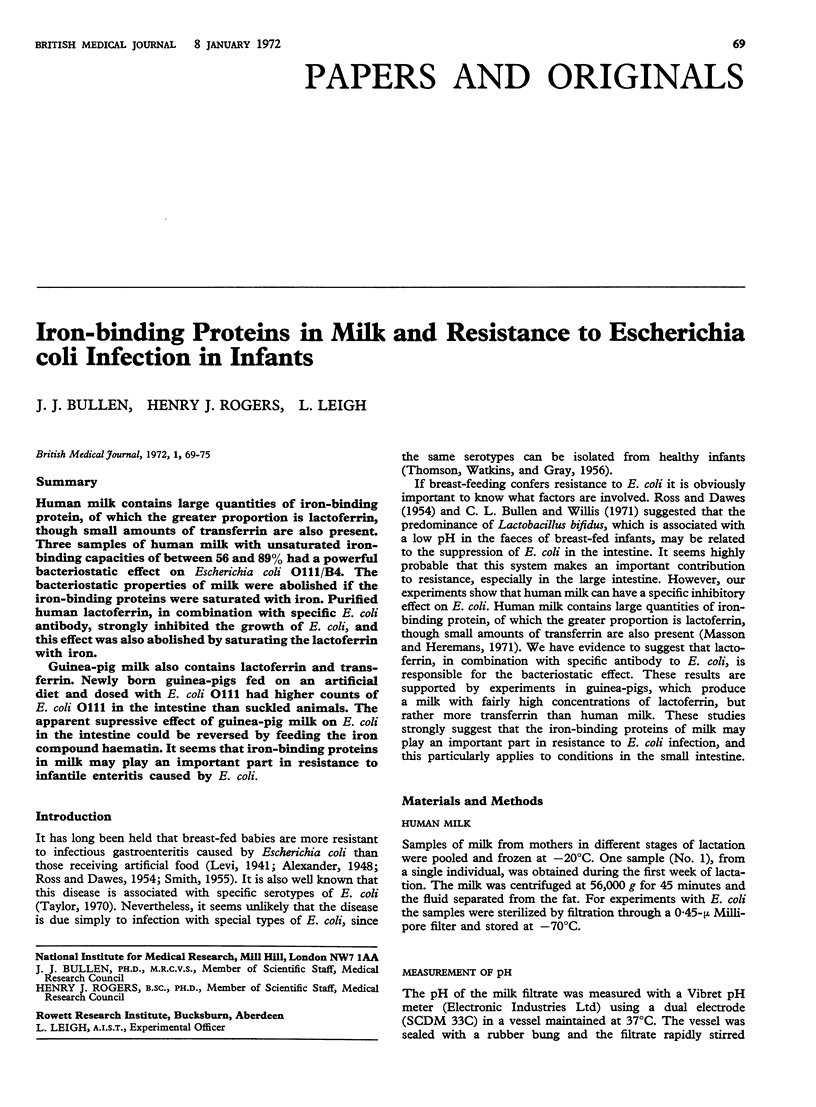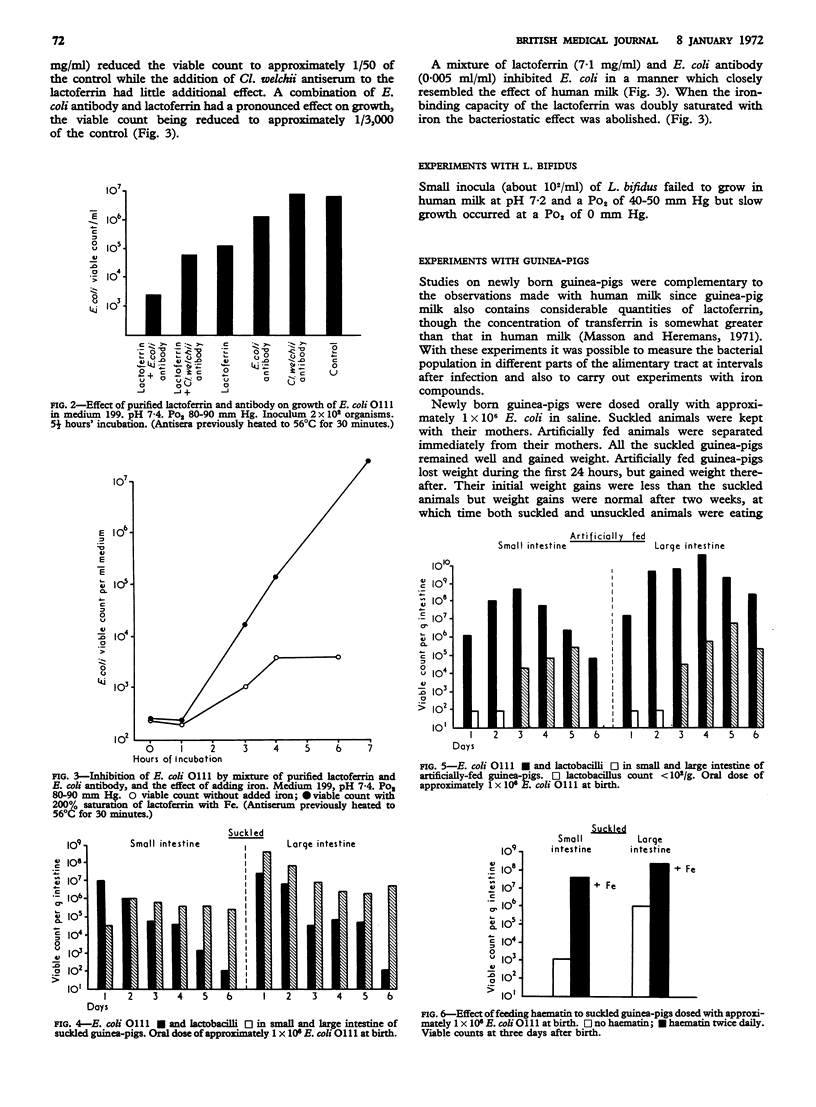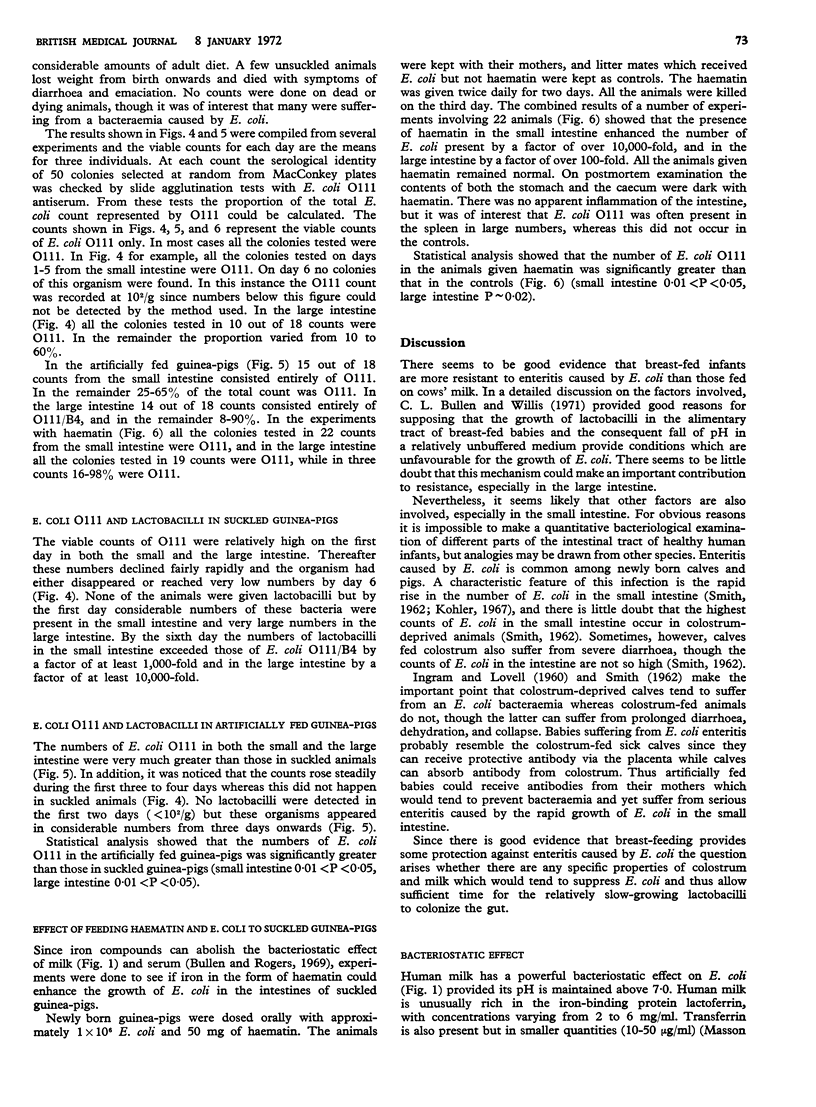Abstract
Human milk contains large quantities of iron-binding protein, of which the greater proportion is lactoferrin, though small amounts of transferrin are also present. Three samples of human milk with unsaturated iron-binding capacities of between 56 and 89% had a powerful bacteriostatic effect on Escherichia coli O111/B4. The bacteriostatic properties of milk were abolished if the iron-binding proteins were saturated with iron. Purified human lactoferrin, in combination with specific E. coli antibody, strongly inhibited the growth of E. coli, and this effect was also abolished by saturating the lactoferrin with iron.
Guinea-pig milk also contains lactoferrin and transferrin. Newly born guinea-pigs fed on an artificial diet and dosed with E. coli O111 had higher counts of E. coli O111 in the intestine than suckled animals. The apparent suppressive effect of guinea-pig milk on E. coli in the intestine could be reversed by feeding the iron compound haematin. It seems that iron-binding proteins in milk may play an important part in resistance to infantile enteritis caused by E. coli.
Full text
PDF






Selected References
These references are in PubMed. This may not be the complete list of references from this article.
- BASCH R. S. INHIBITION OF THE THIRD COMPONENT OF THE COMPLEMENT SYSTEM BY DERIVATIVES OF AROMATIC AMINO ACIDS. J Immunol. 1965 Apr;94:629–640. [PubMed] [Google Scholar]
- BLANC B., ISLIKER H. [Isolation and characterization of the red siderophilic protein from maternal milk: lactotransferrin]. Bull Soc Chim Biol (Paris) 1961;43:929–943. [PubMed] [Google Scholar]
- BULLEN J. J., DOBSON A., WILSON A. B. BACTERIOSTATIC EFFECTS OF SPECIFIC ANTISERUM ON CLOSTRIDIUM WELCHII TYPE A. THE ROLE OF EH AND PH OF THE MEDIUM. J Gen Microbiol. 1964 May;35:175–182. doi: 10.1099/00221287-35-2-175. [DOI] [PubMed] [Google Scholar]
- BULLEN J. J., WILSON A. B., CORDINER K. The effect of normal and immune sera on the growth of Clostridium welchii type A in the allantoic cavity of embryonated hen eggs. J Pathol Bacteriol. 1961 Oct;82:383–401. [PubMed] [Google Scholar]
- Bates G. W., Billups C., Saltman P. The kinetics and mechanism of iron (3) exchange between chelates and transferrin. I. The complexes of citrate and nitrilotriacetic acid. J Biol Chem. 1967 Jun 25;242(12):2810–2815. [PubMed] [Google Scholar]
- Bullen C. L., Willis A. T. Resistance of the breast-fed infant to gastroenteritis. Br Med J. 1971 Aug 7;3(5770):338–343. doi: 10.1136/bmj.3.5770.338. [DOI] [PMC free article] [PubMed] [Google Scholar]
- Bullen J. J., Cushnie G. H., Rogers H. J. The abolition of the protective effect of Clostridium welchii type A antiserum by ferric iron. Immunology. 1967 Mar;12(3):303–312. [PMC free article] [PubMed] [Google Scholar]
- Bullen J. J., Leigh L. C., Rogers H. J. The effect of iron compounds on the virulence of Escherichia coli for guinea-pigs. Immunology. 1968 Oct;15(4):581–588. [PMC free article] [PubMed] [Google Scholar]
- Bullen J. J., Rogers H. J. Bacterial iron metabolism and immunity to Pasteurella septica and Escherichia coli. Nature. 1969 Oct 25;224(5217):380–382. doi: 10.1038/224380a0. [DOI] [PubMed] [Google Scholar]
- Bullen J. J., Rogers H. J., Lewin J. E. The bacteriostatic effect of serum on Pasteurella septica and its abolition by iron compounds. Immunology. 1971 Mar;20(3):391–406. [PMC free article] [PubMed] [Google Scholar]
- Bullen J. J., Wilson A. B., Cushnie G. H., Rogers H. J. The abolition of the protective effect of Pasteurella septica antiserum by iron compounds. Immunology. 1968 Jun;14(6):889–898. [PMC free article] [PubMed] [Google Scholar]
- Fletcher J., Goldstein E. The effect of parenteral iron preparations on experimental pyelonephritis. Br J Exp Pathol. 1970 Jun;51(3):280–285. [PMC free article] [PubMed] [Google Scholar]
- GRAY O. P., THOMSON S., WATKINS A. G. Escherichia coli gastro-enteritis. Arch Dis Child. 1956 Oct;31(159):340–345. doi: 10.1136/adc.31.159.340. [DOI] [PMC free article] [PubMed] [Google Scholar]
- Griffiths E. Mechanism of action of specific antiserum on Pasteurella septica. Selective inhibition of net macromolecular synthesis and its reversal by iron compounds. Eur J Biochem. 1971 Nov 11;23(1):69–76. doi: 10.1111/j.1432-1033.1971.tb01593.x. [DOI] [PubMed] [Google Scholar]
- Griffiths E. Selective inhibition of macromolecular synthesis in Pasteurella septica by antiserum and its reversal by iron. Nat New Biol. 1971 Jul 21;232(29):89–90. doi: 10.1038/newbio232089a0. [DOI] [PubMed] [Google Scholar]
- LASKOWSKI M., Jr, LASKOWSKI M. Crystalline trypsin inhibitor from colostrum. J Biol Chem. 1951 Jun;190(2):563–573. [PubMed] [Google Scholar]
- MASON S. Some aspects of gastric function in the newborn. Arch Dis Child. 1962 Aug;37:387–391. doi: 10.1136/adc.37.194.387. [DOI] [PMC free article] [PubMed] [Google Scholar]
- Masson P. L., Heremans J. F. Lactoferrin in milk from different species. Comp Biochem Physiol B. 1971 May 15;39(1):119–129. doi: 10.1016/0305-0491(71)90258-6. [DOI] [PubMed] [Google Scholar]
- Masson P. L., Heremans J. F., Schonne E. Lactoferrin, an iron-binding protein in neutrophilic leukocytes. J Exp Med. 1969 Sep 1;130(3):643–658. doi: 10.1084/jem.130.3.643. [DOI] [PMC free article] [PubMed] [Google Scholar]
- Melching L., Vas S. I. Effects of serum components on gram-negative bacteria during bactericidal reactions. Infect Immun. 1971 Jan;3(1):107–115. doi: 10.1128/iai.3.1.107-115.1971. [DOI] [PMC free article] [PubMed] [Google Scholar]
- ROSS C. A., DAWES E. A. Resistance of the breast-fed infant to gastro-enteritis. Lancet. 1954 May 15;266(6820):994–998. doi: 10.1016/s0140-6736(54)92395-8. [DOI] [PubMed] [Google Scholar]
- Rogers H. J., Bullen J. J., Cushnie G. H. Iron compounds and resistance to infection. Further experiments with Clostridium welchii type A in vivo and in vitro. Immunology. 1970 Oct;19(4):521–538. [PMC free article] [PubMed] [Google Scholar]
- SMITH H. W. Observations on the aetiology of neonatal diarrhoea (scours) in calves. J Pathol Bacteriol. 1962 Jul;84:147–168. [PubMed] [Google Scholar]
- Taylor J. Infectious infantile enteritis, yesterday and today. Proc R Soc Med. 1970 Dec;63(12):1297–1301. [PMC free article] [PubMed] [Google Scholar]


